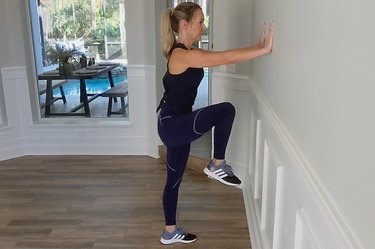

Glute bridges, 90/90s and froggers are good stretches for loosening up cranky hips, but there's one highly underrated stretch missing in your mobility routine: the hip controlled articular rotation (CAR).
"Hip CARs can help improve mobility, joint health and range of motion by moving one single joint through its absolute full range while keeping the rest of your body still and contracted," says Grayson Wickham PT, DPT, CSCS, a physical therapist and founder of Movement Vault.
Video of the Day
Unlike static stretches that require you to hold a pose for a few seconds, standing hip CARs actively move your hip joint to the front, side and back. Your hip joint is a ball and socket joint, which means the rounded end of the femur (your thigh bone) fits into a socket that allows your leg to move in a complete circle. However, it's rare that we move our legs in a complete circle — and that's what makes the hip CAR so great.
Warning
Avoid the standing hip CAR if you have had a hip replacement. If you have arthritis or a prior hip injury or surgery, talk to your doctor before trying a new exercise. Be sure to keep the motion in your pain-free range.
How to Do a Standing Hip CAR Stretch
Standing Hip CAR Stretch
- Stand facing a wall and place both hands on it for stability.
- Lift your right knee up as high as you can, stopping before your back starts to round.
- With your knee lifted, bring it to the side without turning your hips. Make sure you keep your hip bones pointing straight.
- Then, rotate your knee inward to internally rotate your hip.
- Bring your leg back behind you, ensuring your hips are still facing forward and completing a circle with your leg. Don’t over-arch your back.
- Repeat this movement pattern by bringing your knee to the starting position.
- Do this stretch for 30 to 60 seconds on each leg up to twice daily.
5 Hip CAR Stretch Benefits
1. It Keeps Your Hip Joint Tissues Healthy
"Your joint connective tissue and cartilage receive nutrition when you move your joints," Wickham says.
Moving your hips at a full range of motion — like doing standing hip CARs — allows the synovial fluid (fluid inside your joints) to reach all of your joint cartilage to keep it healthy.
2. It Improves Hip Range of Motion
The hip CAR stretch ensures that the hip joint moves throughout its intended range of motion. When doing the stretch, you might feel that certain areas are tighter than others, but the more you do it, the more flexible and mobile your hips will be.
3. It Strengthens Your Hips
When doing hip CARs, you have to contract all of the muscles that surround and control your leg and hip. Performing this stretch — slowly — on a regular basis will help strengthen your hip muscles.
4. It Reduces Hip Pain
This stretch encourages synovial fluid to move around all the crevices of your joints while keeping them mobile and strong — all of these factors help decrease hip pain.
5. It Enhances Your Balance
Incorporating this stretch into your daily routine can help improve your proprioception, aka body awareness. As you're slowly moving one leg at a time in a complete circle, you'll improve your balance by actively engaging your muscles.
3 Hip CAR Stretch Tips
1. Move Slowly
"CARs should be performed at a slow pace as this is the optimal speed that allows you to focus while contracting all of your muscles around the joint through your pain-free range," Wickham says. "If you perform these too fast, you will most likely not be moving your joint through its absolute maximum range of motion."
2. Keep the Motion in Your Pain-Free Range
Don't force your hip to move in a range of motion that causes pain. A stretch or slight discomfort is fine, but sharp pain is not. The more you perform CARs, the more your pain-free range of motion and flexibility will increase.
3. Focus On Keeping Your Body Still
The only thing that should be moving is your hip joint. Your hips and shoulders should stay pointed to the wall in front of you as your hip joint moves through its full range of motion.
"To increase the effectiveness of CARs, contract all of the muscles in your body to help it stay still," Wickham says. "You get out what you put into CARs. It's very easy to just go through the motions with CARs (no pun intended). You really need to concentrate during the movement."